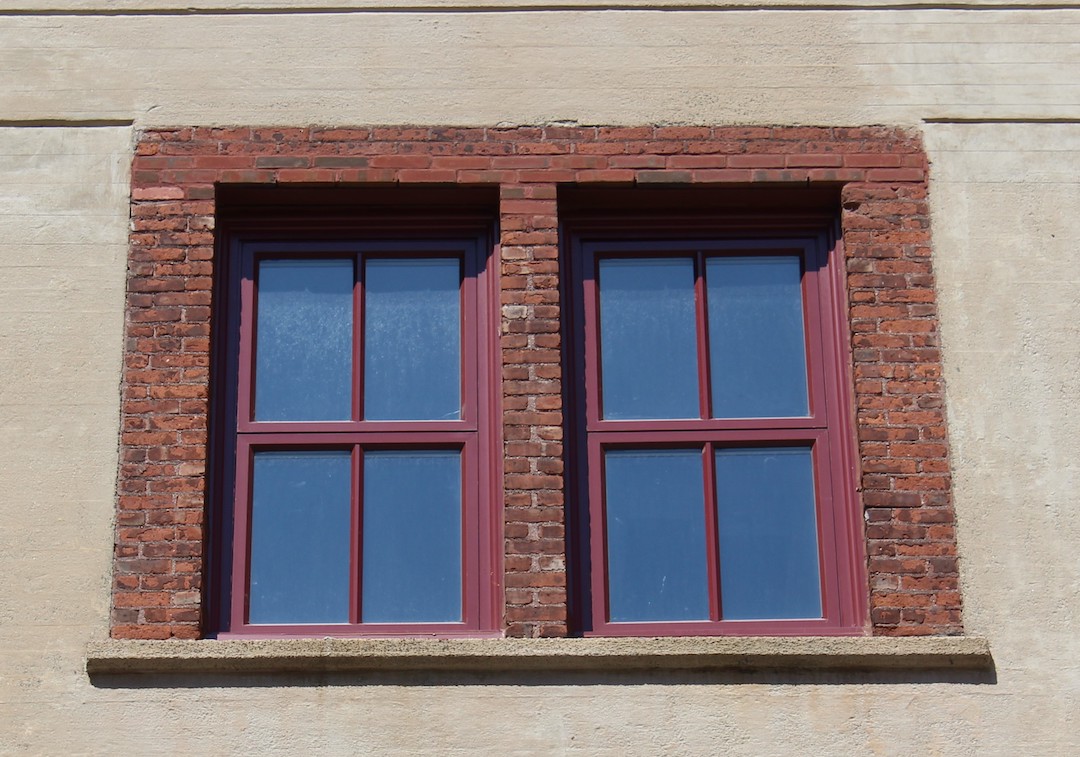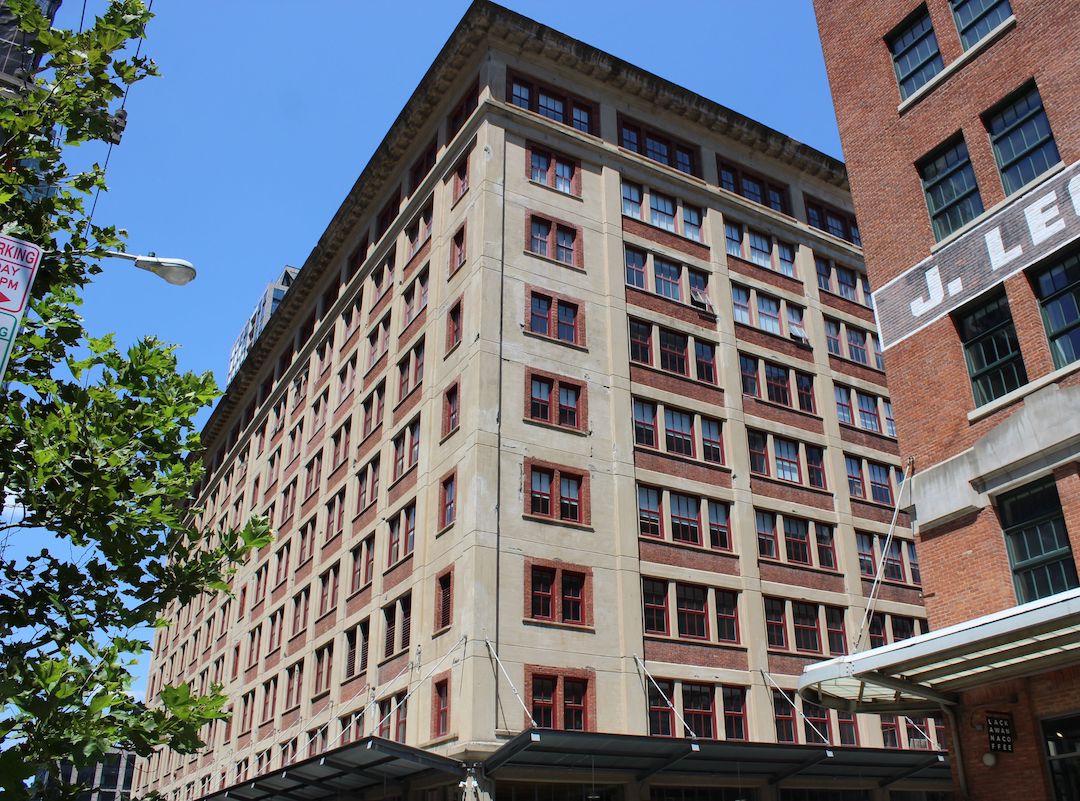Crystal Window & Door Systems products played a major role in the recent restoration and repurposing of a landmark building in Jersey City, N.J. The 10-story building at 150 Bay Street used 515 custom-modified Crystal windows on all four façades to retain the appearance and character of the 113-year-old historic structure.
The 150 Bay Street rehabilitation included the restoration of the brick and masonry façade, ornate roof cornice, and cantilevered cable-supported loading dock shed roofs. Replacing the antiquated wood windows with a modern window system that retained the historic characteristics of the building added to the challenge.
Crystal Window & Door Systems worked closely with the fenestration installer, BlueSky Windows, and the project architect and general contractor. Crystal fast-tracked the concept of, design, and fabrication of a custom window system solution which met and exceeded the project’s historic restoration requirements.
Custom-modified window system
The Crystal custom-modified window system replicates the original tall double-hung wood windows with a unique modern energy-efficient vertically stacked twin project-out awning aluminum window.
To truly deliver the project’s historic look, Crystal’s engineers used the resources of the company’s aluminum supply partners and its extrusion subsidiary to custom produce a special-frame variant of a standard projected window product, fabricate a 3-piece simulated divided light system, and replicate a historic-look sash with a 1-inch putty-line-look glazing bead as well as historic panning.
The 150 Bay Street project used Crystal’s Series 8620 Project-Out Awning windows. The Series 8620 windows were ordered in 2-lite vertically-stacked configurations and custom modified to suit the historic appearance requirements of the renovation project. With the building’s 14-foot-high loft ceiling heights, the windows are all very tall, the largest being 58½ inches wide by 81 inches high.
The Crystal Series 8620 is a top-of-the-line 3¼-inch thermal-broken frame awning window with an AW-PG80 rating. The energy-efficient window features 1” dual-pane insulated glass with warm edge spacer and argon filling, as well as two rows of bulb weatherstripping around the sash perimeter.
The Crystal Series 8620 offers cam lock handles and four-bar HS/SS friction hinges to hold the sash in open positions. Optional sash opening limit devices were also specified.

To meet the project’s historic specifications, Crystal made several custom modifications to the Series 8620. To emulate the building’s original wood windows, Crystal designed custom sash and frame extrusions, which its supply partners fabricated.
While the 2-lite stacked awning windows replicate the horizontal meeting rail of the original double-hung windows, each sash used special custom vertical simulated divided light (SDL) components to improve the historic aesthetics. The SDL components consisted of a standard colonial ⅝” between-the-glass grid with aligned 1¾-inch raised trapezoidal profile colonial tape-on aluminum grids affixed to the interior and exterior glass.
The project also required Crystal to produce several custom aluminum historic panning extrusions for the head, jamb, and sill of the window openings. All the Crystal windows, panning, grid components, and visible installation accessories were finished in a two-tone special Arroyo Red exterior and white interior to enhance the historic appearance of the building.
Key players for the Bay Street renovation project included fenestration installer BlueSky Windows and architect Fifield-Piaker-Elman Architects, both of New York City.
Three floors devoted to student housing
The repurposed 10-story, 203,000-square-foot building at 150 Bay Street now features ground-floor retail, art studio workspaces on the second floor, and business offices on the third floor. The upper floors are residential loft apartments, with three floors used by Nyack College as student residences, and luxury penthouses on the top floor.
Besides its historic, retro exterior, the building has many new features such as a roof patio, lounge areas, and a fitness center. The building is located in the Powerhouse Arts District, a lively artisan and business enclave in Jersey City.
Part of the resurgence of the state’s second largest city of over 250,000 residents, the Powerhouse Arts District has cobblestone streets, rehabbed former industrial buildings, shops, coffee houses, restaurants, bars, outdoor streetscape spaces, and art galleries.
Related Stories
| Oct 13, 2010
HQ renovations aim for modern look
Gerner Kronick + Valcarcel Architects’ renovations to the Commonwealth Bank of Australia’s New York City headquarters will feature a reworked reception lobby with back-painted glass, silk-screened logos, and a video wall.
| Oct 13, 2010
New health center to focus on education and awareness
Construction is getting pumped up at the new Anschutz Health and Wellness Center at the University of Colorado, Denver. The four-story, 94,000-sf building will focus on healthy lifestyles and disease prevention.
| Oct 13, 2010
Community center under way in NYC seeks LEED Platinum
A curving, 550-foot-long glass arcade dubbed the “Wall of Light” is the standout architectural and sustainable feature of the Battery Park City Community Center, a 60,000-sf complex located in a two-tower residential Lower Manhattan complex. Hanrahan Meyers Architects designed the glass arcade to act as a passive energy system, bringing natural light into all interior spaces.
| Oct 13, 2010
Community college plans new campus building
Construction is moving along on Hudson County Community College’s North Hudson Campus Center in Union City, N.J. The seven-story, 92,000-sf building will be the first higher education facility in the city.
| Oct 13, 2010
County building aims for the sun, shade
The 187,032-sf East County Hall of Justice in Dublin, Calif., will be oriented to take advantage of daylighting, with exterior sunshades preventing unwanted heat gain and glare. The building is targeting LEED Silver. Strong horizontal massing helps both buildings better match their low-rise and residential neighbors.
| Oct 12, 2010
Holton Career and Resource Center, Durham, N.C.
27th Annual Reconstruction Awards—Special Recognition. Early in the current decade, violence within the community of Northeast Central Durham, N.C., escalated to the point where school safety officers at Holton Junior High School feared for their own safety. The school eventually closed and the property sat vacant for five years.
| Oct 12, 2010
Richmond CenterStage, Richmond, Va.
27th Annual Reconstruction Awards—Bronze Award. The Richmond CenterStage opened in 1928 in the Virginia capital as a grand movie palace named Loew’s Theatre. It was reinvented in 1983 as a performing arts center known as Carpenter Theatre and hobbled along until 2004, when the crumbling venue was mercifully shuttered.
| Oct 12, 2010
University of Toledo, Memorial Field House
27th Annual Reconstruction Awards—Silver Award. Memorial Field House, once the lovely Collegiate Gothic (ca. 1933) centerpiece (along with neighboring University Hall) of the University of Toledo campus, took its share of abuse after a new athletic arena made it redundant, in 1976. The ultimate insult occurred when the ROTC used it as a paintball venue.
| Oct 12, 2010
Cell and Genome Sciences Building, Farmington, Conn.
27th Annual Reconstruction Awards—Silver Award. Administrators at the University of Connecticut Health Center in Farmington didn’t think much of the 1970s building they planned to turn into the school’s Cell and Genome Sciences Building. It’s not that the former toxicology research facility was in such terrible shape, but the 117,800-sf structure had almost no windows and its interior was dark and chopped up.
| Oct 12, 2010
The Watch Factory, Waltham, Mass.
27th Annual Reconstruction Awards — Gold Award. When the Boston Watch Company opened its factory in 1854 on the banks of the Charles River in Waltham, Mass., the area was far enough away from the dust, dirt, and grime of Boston to safely assemble delicate watch parts.

















